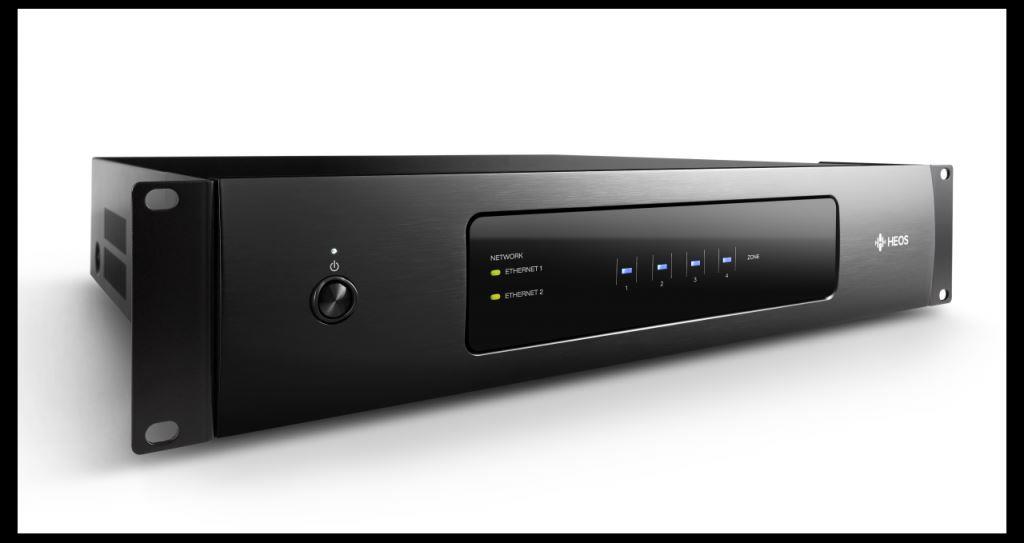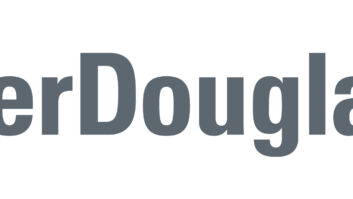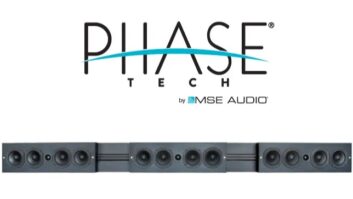
Mahwah, N.J. – Denon is adapting its Heos wireless multiroom-audio technology for use in installed multiroom-audio systems.
The company plans July shipments of the $2,499-suggested Heos Drive, a component-size rack-mountable four-zone preamp/amp that incorporates Heos technology to distribute network-music sources and cloud sources around the house. Like the company’s Wi-Fi-equipped Heos tabletop speakers, the Drive can be controlled from Denon’s Heos app for smartphones and tablets.
The Drive, however, lacks the wireless capabilities of current Heos products, so it distributes music via speaker cables to in-wall and in-ceiling speakers, and it connects to the home network via Ethernet cable, not via Wi-Fi.
Denon’s current Heos app will control a Drive along with a mix of wireless Heos speakers placed in rooms where wired custom speakers can’t be installed, said product manager Paul Belanger. The Drive appears as four zones in the Heos app, he said.
Up to eight Drives can be installed to create a custom-installed multiroom-audio system with up to 32 wired zones.
Until now, installers who wanted to add Heos’ streaming capabilities to a wired multiroom-audio system had to add multiple separate $499 Heos Amps or multiple separate $349 Heos Link preamps, each equipped with Wi-Fi and Ethernet, to a central home-automation rack. The Heos Amp is normally connected to any pair of passive tabletop speakers, and the Heos Link preamp connects to existing sound systems.
Mixing these tabletop Heos devices, which aren’t standard component-size, with standard-size home-automation components makes a rack look cluttered and disorderly, Belanger said. Each Heos Amp or Link also has to have its own power cable and, if their Wi-Fi isn’t used, its own Ethernet cable, further contributing to rack clutter, he added.
The Drive will be available only through custom-install channels and won’t appear on retail sales floors or online, Belanger noted.
Other Heos products include the recently announced $199 Heos 1 mono tabletop speaker and the $599 Heos 7, $399 Heos 5, and $299 Heos 3 stereo speakers.
Music is sent to the devices via controller apps running on iOS and Android devices and on the Kindle Fire tablet. Music sources that can be distributed throughout the house can be stored on the mobile device, on networked sources such as NAS drives and PCs, and on USB sticks and USB hard drives plugged into a Heos device. Heos devices also stream cloud-based music services, including Spotify, SiriusXM, Pandora, Rhapsody, TuneIn, and iHeartRadio.
The Heos Drive accesses all of the same sources, but it incorporates eight-channel amp rated at 70 watts per channel into 8 ohms from 20Hz-20kHz. It’s stable to 4 ohms. A Denon API available since December enables integration into home-control systems from RTI, Crestron, Key Digital, and Roomie Remote. And control from Control4, URC, and AMX home-control systems is in the works. The API also delivers third-party control of the Heos Amp and Heos Link.
Another Drive feature is an optical input that accepts Dolby Digital 5.1 audio from a cable box or Apple TV and downmixes it to two channels for distribution throughout the house. The capability preserves the ability to play back a program in 5.1 in the home theater room.












